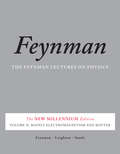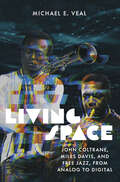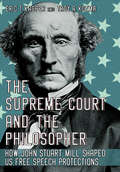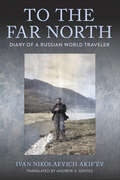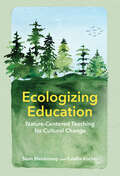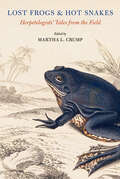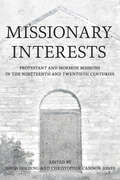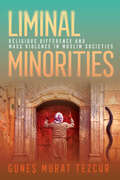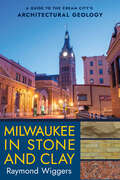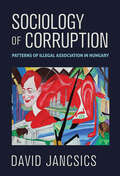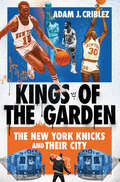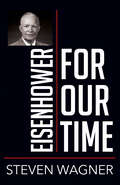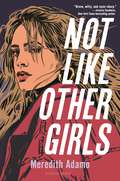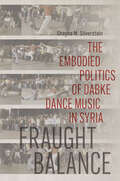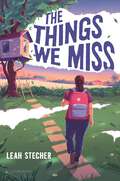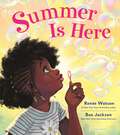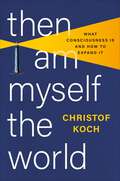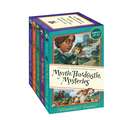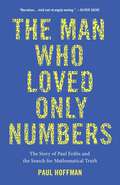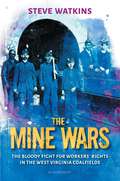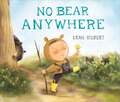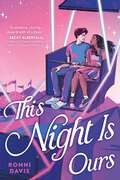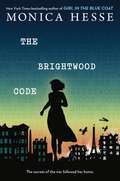- Table View
- List View
The Feynman Lectures on Physics, Vol. II: The New Millennium Edition: Mainly Electromagnetism and Matter
by Richard P. Feynman Robert B. Leighton Matthew Sands"The whole thing was basically an experiment," Richard Feynman said late in his career, looking back on the origins of his lectures. The experiment turned out to be hugely successful, spawning publications that have remained definitive and introductory to physics for decades. Ranging from the basic principles of Newtonian physics through such formidable theories as general relativity and quantum mechanics, Feynman's lectures stand as a monument of clear exposition and deep insight.Timeless and collectible, the lectures are essential reading, not just for students of physics but for anyone seeking an introduction to the field from the inimitable Feynman.
Living Space: John Coltrane, Miles Davis, and Free Jazz, from Analog to Digital (Music / Culture)
by Michael E. VealLiving Space: John Coltrane, Miles Davis, and Free Jazz, from Analog to Digital fuses biography and style history in order to illuminate the music of two jazz icons, while drawing on the discourses of photography and digital architecture to fashion musical insights that may not be available through the traditional language of jazz analysis. The book follows the controversial trajectories of two jazz legends, emerging from the 1959 album Kind of Blue. Coltrane's odyssey through what became known as "free jazz" brought stylistic (r)evolution and chaos in equal measure. Davis's spearheading of "jazz-rock fusion" opened a door through which jazz's ongoing dialogue with the popular tradition could be regenerated, engaging both high and low ideas of creativity, community, and commerce. Includes 42 illustrations.
The Supreme Court and the Philosopher: How John Stuart Mill Shaped US Free Speech Protections
by Eric T. Kasper Troy A. KozmaThe Supreme Court and the Philosopher illustrates how the modern US Supreme Court has increasingly adopted a view of the constitutional right to the freedom of expression that is classically liberal in nature, reflecting John Stuart Mill's reasoning in On Liberty. A landmark treatise outlining the merits of limiting governmental and social power over the individual, On Liberty advocates for a maximum protection of human freedom. Proceeding case by case and covering a wide array of issues, such as campaign finance, offensive speech, symbolic speech, commercial speech, online expression, and false statements, Eric T. Kasper and Troy A. Kozma show how the Supreme Court justices have struck down numerous laws for infringing on the freedom of expression.Kasper and Kozma demonstrate how the adoption of Mill's version of free speech began with Justice Oliver Wendell Holmes Jr. more than a century ago and expanded over time to become the prevailing position of the Court today. The authors argue that this embrace of Mill's rationale has led to an unmistakable reorientation in the Court's understanding of free expression jurisprudence.The Supreme Court and the Philosopher is the first book to comprehensively explore how the political philosophy of Mill has influenced the highest court in the land. In targeting the underlying philosophical reasons that explain why the modern Supreme Court renders its First Amendment decisions, this book is particularly timely, as the issues of censorship and freedom of expression are debated in the public square today.
To the Far North: Diary of a Russian World Traveler (NIU Series in Slavic, East European, and Eurasian Studies)
by Ivan Nikolaevich Akif’ëvThis annotated translation of To the Far North presents the diary of a twenty-seven-year-old Russian physician who was part of the 1900 expedition to the Chukotka Peninsula to find gold. No other account so richly details life along the North Pacific Rim before World War I, especially from a Russian perspective. This volume relates the expedition's formation, development, and aftermath and offers unique insights on the region's place in both Russian policymaking and geopolitics. The illustrated diary includes picturesque descriptions of San Francisco, the Nome Gold Rush, Chukchi culture, Petropavlovsk, Vladivostok, and Nagasaki, Japan.Andrew A. Gentes's translation is based on an edition of Akifëv's book that was published in St. Petersburg in 1904. The diary shows how Russian and American views and cultural values clashed over a territory that is today more geopolitically important than ever. By documenting Akifëv's personal travels outside the expedition, To the Far North also demonstrates, in both human and personal terms, the role Russians played in shaping this region's history.
Ecologizing Education: Nature-Centered Teaching for Cultural Change
by Sean Blenkinsop Estella C. KuchtaEcologizing Education explores how we can reenvision education to meet the demands of an unjust and rapidly changing world. Going beyond "green" schooling programs that aim only to shape behavior, Sean Blenkinsop and Estella Kuchta advance a pedagogical approach that seeks to instills eco-conscious and socially just change at the cultural level. Ecologizing education, as this approach is called, involves identifying and working to overcome anti-ecological features of contemporary education. This approach, called ecologizing education, aims to develop a classroom culture in sync with the more-than-human world where diversity and interdependency are intrinsic.Blenkinsop and Kuchta illustrate this educational paradigm shift through the real-world stories of two public elementary schools located in British Columbia. They show that this approach to learning starts with recognizing the environmental and social injustices that pervade our industrialized societies. By documenting how ecologizing education helps children create new relationships with the natural world and move toward mutual healing, Blenkinsop and Kuchta offer a roadmap for what may be the most potent chance we have at meaningful change in the face of myriad climate crises. Timely, practical, and ultimately inspirational, Ecologizing Education is vital reading for any parent, caregiver, environmentalist, or educator looking for wholistic education that places nature and the environment front and center.
Lost Frogs and Hot Snakes: Herpetologists' Tales from the Field
by Martha L. CrumpLost Frogs and Hot Snakes reveals the thrills and travails that herpetologists experience when working with amphibians and reptiles in the wild. With essays from fifty field biologists, this volume, edited by Martha L. Crump, presents a multifaceted yet intimate look at life in pursuit of knowledge about the natural world. From the beaches of Peru to the mountains of China, the stories in this collection place readers in the boots of field biologists as they watch, count, experiment, and survey. Some recall mishaps and misadventures—contending with leeches, dangling off a precipice while in a truck. Others tell of once-in-a-lifetime encounters—discovering a new frog species, spotting a rare snake. Together, these stories offer an understanding of what field biology is, what field biologists do, and how they go about doing it. Written with candor, warmth, and a dash of humor, the stories in Lost Frogs and Hot Snakes will encourage readers to appreciate the value of engaging with nature and of the amphibians and reptiles so critical to the vitality of our planet.
Missionary Interests: Protestant and Mormon Missions of the Nineteenth and Twentieth Centuries
by Edited by David Golding and Christopher Cannon JonesIn Missionary Interests, David Golding and Christopher Cannon Jones bring together works about Protestant and Mormon missionaries in the nineteenth and twentieth centuries, charting new directions for the historical study of these zealous evangelists for their faith. Despite their sectarian differences, both groups of missionaries shared notions of dividing the world categorically along the lines of race, status, and relative exoticism, and both employed humanitarian outreach with designs to proselytize.American missionaries occupied liminal spaces: between proselytizer and proselytized, feminine and masculine, colonizer and colonized. Taken together, the chapters in Missionary Interests dismantle easy characterizations of missions and conversion and offer an overlooked juxtaposition between Mormon and Protestant missionary efforts in the nineteenth and twentieth centuries.
Liminal Minorities: Religious Difference and Mass Violence in Muslim Societies (Religion and Conflict)
by Günes Murat TezcürLiminal Minorities addresses the question of why some religious minorities provoke the ire of majoritarian groups and become targets of organized violence, even though they lack significant power and pose no political threat. Güneş Murat Tezcür argues that these faith groups are stigmatized across generations, as they lack theological recognition and social acceptance from the dominant religious group. Religious justifications of violence have a strong mobilization power when directed against liminal minorities, which makes these groups particularly vulnerable to mass violence during periods of political change.Offering the first comparative-historical study of mass atrocities against religious minorities in Muslim societies, Tezcür focuses on two case studies—the Islamic State's genocidal attacks against the Yezidis in northern Iraq in the 2010s and massacres of Alevis in Turkey in the 1970s and 1990s—while also addressing discrimination and violence against followers of the Bahá'í faith in Iran and Ahmadis in Pakistan and Indonesia. Analyzing a variety of original sources, including interviews with survivors and court documents, Tezcür reveals how religious stigmatization and political resentment motivate ordinary people to participate in mass atrocities.
Milwaukee in Stone and Clay: A Guide to the Cream City's Architectural Geology
by Raymond WiggersMilwaukee in Stone and Clay follows directly in the footsteps of Raymond Wiggers's previous award-winning book, Chicago in Stone and Clay. It offers a wide-ranging look at the fascinating geology found in the building materials of Milwaukee County's architectural landmarks. And it reveals the intriguing and often surprising links between science, art, and engineering. Laid out in two main sections, the book first introduces the reader to the fundamentals of Milwaukee's geology and its amazing prehuman history, then provides a site-by-site tour guide. Written in an engaging, informal style, this work presents the first in-depth exploration of the interplay among the region's most architecturally significant sites, the materials they're made of, and the sediments and bedrock they're anchored in. Raymond Wiggers crafted Milwaukee in Stone and Clay as an informative and exciting overview of this city. His two decades of experience leading architectural-geology tours have demonstrated the popularity of this approach and the subject matter.
Sociology of Corruption: Patterns of Illegal Association in Hungary
by David JancsicsIn Sociology of Corruption, David Jancsics provides a fresh approach to the study of corruption in Hungary, which once seemed to be the most likely of the ex-communist bloc nations to catch up to the West and is, according to many experts and scholars, a country with a highly corrupt dynamic.Based on data from 2022, Hungary is now the most corrupt member state of the European Union. There is also a consensus among experts that a small clique of corrupt political actors has captured most Hungarian state institutions and a significant portion of the business sector. What fostered corruption in Hungary? What are the most typical forms of corruption in this country? What do Hungarians think about it? What is the role of prime minister Viktor Orbán in this? Sociology of Corruption proposes a novel sociological theory of corruption focusing on social status and relationships, network structures, and power dynamics as important explanatory factors of corrupt behavior. Although his focus is on Hungary, Jancsics's findings are applicable to other nations and cultural contexts.
Kings of the Garden: The New York Knicks and Their City
by Adam J. CriblezIn Kings of the Garden, Adam J. Criblez traces the fall and rise of the New York Knicks between the 1973, the year they won their last NBA championship, and 1985, when the organization drafted Patrick Ewing and gave their fans hope after a decade of frustrations. During these years, the teams led by Walt Frazier, Earl Monroe, Bob McAdoo, Spencer Haywood, and Bernard King never achieved tremendous on-court success, and their struggles mirrored those facing New York City over the same span. In the mid-seventies, as the Knicks lost more games than they won and played before smaller and smaller crowds, the city they represented was on the brink of bankruptcy, while urban disinvestment, growing income inequality, and street gangs created a feeling of urban despair. Kings of the Garden details how the Knicks' fortunes and those of New York City were inextricably linked. As the team's Black superstars enjoyed national fame, Black musicians, DJs, and B-boys in the South Bronx were creating a new culture expression—hip-hop—that like the NBA would become a global phenomenon. Criblez's fascinating account of the era shows that even though the team's efforts to build a dynasty ultimately failed, the Knicks, like the city they played in, scrappily and spectacularly symbolized all that was right—and wrong—with the NBA and the nation during this turbulent, creative, and momentous time.
Eisenhower for Our Time (People for Our Time)
by Steven WagnerEisenhower for Our Time provides an introduction to the Eisenhower presidency, extracting lessons for today's world. Steven Wagner proposes that the need to maintain balance defines Eisenhower's presidency. Wagner examines a series of defining moments that were among Eisenhower's greatest challenges, some of which resulted in his greatest accomplishments: the decision to run for president, his political philosophy of the "Middle Way," the creation of a national security policy, the French Indochina War, Senator Joseph McCarthy, the Little Rock Desegregation Crisis, the Race for Space, and the famous Farewell Address. Wagner looks at Eisenhower's executive ability, leadership, decision making, and willingness to compromise, as well as the qualities of duty, integrity, and good character. The moments detailed in Eisenhower for Our Time show Eisenhower as a president intimately engaged in the decisions that defined America in his time and that apply to ours today. The President's actions place him among the most successful presidents and provide many lessons to guide us in our time and in the future.
Not Like Other Girls
by Meredith Adamo“Powerful, brilliantly plotted, voicey, gripping, beautiful, heart-wrenching, hilarious . . . Read this book.” -Liz Lawson, New York Times bestselling author of The AgathasWhen Jo-Lynn Kirby 's former best friend-pretty, nice Maddie Price-comes to her claiming to be in trouble, Jo assumes it's some kind of joke. After all, Jo has been an outcast ever since her nude photos were leaked-and since everyone decided she deserved it. There's no way Maddie would actually come to her for help.But then Maddie is gone.Everyone is quick to write off Maddie as a runaway, but Jo can't shake the feeling there's more to the story. To find out the truth, Jo needs to get back in with the people who left her behind-and the only way back in is through Hudson Harper-Moore. An old fling of Jo's with his own reasons for wanting to find Maddie, Hudson hatches a fake dating scheme to get Jo back into their clique. But being back on the inside means Jo must confront everything she'd rather forget: the boys who betrayed her, the whispers that she had it coming, and the secrets that tore her and Maddie apart. As Jo digs deeper into Maddie's disappearance, she's left to wonder who she's really searching for: Maddie, or the girl she used to be.Not Like Other Girls is a stunning debut that takes a hard look at how we treat young women and their trauma, through the lens of a missing girl and a girl trying to find herself again.
Fraught Balance: The Embodied Politics of Dabke Dance Music in Syria (Music / Culture)
by Shayna M. SilversteinDabke, one of Syria's most beloved dance music traditions, is at the center of the country's war and the social tensions that preceded conflict. Drawing on almost two decades of ethnographic, archival, and digital research, Shayna M. Silverstein shows how dabke dance music embodies the fraught dynamics of gender, class, ethnicity, and nationhood in an authoritarian state. The book situates dabke politically, economically, and historically in a broader account of expressive culture in Syria's recent (and ongoing) turmoil. Silverstein shows how people imagine the Syrian nation through dabke, how the state has coopted it, how performances of masculinity reveal—and play with—the tensions and complexities of the broader social imaginary, how forces opposed to the state have used it resistively, and how migrants and refugees have reimagined it in their new homes in Europe and the United States. She offers deeply thoughtful reflections on the ethnographer's ethical and political dilemmas on fieldwork in an authoritarian state. Silverstein's study ultimately questions the limits of authoritarian power, considering the pleasure and play intrinsic to dabke circles as evidence for how performance cultures sustain social life and solidify group bonds while reproducing the societal divides endemic to Syrian authoritarianism.
The Things We Miss
by Leah Stecher"Magical and heartbreaking! You will read this book in one gulp." - Jennifer L. Holm, New York Times-bestselling author of The Fourteenth GoldfishWhen You Reach Me meets Starfish in this heartfelt contemporary middle grade about a misfit girl who finds a way to skip all of the hard parts of life.J.P. Green has always felt out of step. She doesn't wear the right clothes, she doesn't say the right things, and her body…well, she'd rather not talk about it. And seventh grade is shaping up to be the worst year yet. So when J.P. discovers a mysterious door in her neighbor's treehouse, she doesn't hesitate before walking through. The door sends her three days forward in time. Suddenly, J.P. can skip all the worst parts of seventh grade: Fitness tests in P.E., oral book reports, awkward conversations with her mom…she can avoid them all and no one even knows she was gone.But can you live a life without any of the bad parts? Are there experiences out there that you can't miss?This moving middle grade novel about mental health, body acceptance, and self-confidence asks what it truly means to show up for the people you love-and for yourself.
Summer Is Here
by Ms Renée WatsonNew York Times bestselling creators Renée Watson and Bea Jackson offer a picture book ode to a picture-perfect summer day, from sunrise to sunset.Summer is here!No dark clouds in the sky, it's a perfect day for play. What joy will summer bring me today?Summer is finally here, and she's bringing the most perfect day! From sunup to sundown, there's so much to do on this lovely summer day. With summer comes fresh fruit, sweet and tangy, jump ropes for leaping and dancing, and friends at the pool swimming and floating. Summer brings family cookouts under shady trees, gardens overflowing, and the familiar song of the ice-cream truck. This beautiful ode to all the season's sensations follows one girl's perfect day in an exploration of joy, family, friendship, sunshine, and wonder.Her stars shimmer like spilled glitter across the sky. I whisper a wish and say goodbye to the day.I wish summer would stay.Renée Watson celebrates iconic childhood joys in this love letter to summer featuring bright, sun-drenched art from Bea Jackson.
Summer Is Here
by Ms Renée WatsonNew York Times bestselling creators Renée Watson and Bea Jackson offer a picture book ode to a picture-perfect summer day, from sunrise to sunset.Summer is here!No dark clouds in the sky, it's a perfect day for play. What joy will summer bring me today?Summer is finally here, and she's bringing the most perfect day! From sunup to sundown, there's so much to do on this lovely summer day. With summer comes fresh fruit, sweet and tangy, jump ropes for leaping and dancing, and friends at the pool swimming and floating. Summer brings family cookouts under shady trees, gardens overflowing, and the familiar song of the ice-cream truck. This beautiful ode to all the season's sensations follows one girl's perfect day in an exploration of joy, family, friendship, sunshine, and wonder.Her stars shimmer like spilled glitter across the sky. I whisper a wish and say goodbye to the day.I wish summer would stay.Renée Watson celebrates iconic childhood joys in this love letter to summer featuring bright, sun-drenched art from Bea Jackson.
Then I Am Myself the World: What Consciousness Is and How to Expand It
by Christof Koch"Deeply personal and infinitely digestible, Then I Am Myself the World is a remarkable must-read for anyone interested in knowing their mind.&”―Judson Brewer MD, PhD, New York Times–bestselling author of Unwinding Anxiety The world&’s leading investigator of consciousness argues that by understanding what consciousness does—cause change in the world—we can understand its origins and its future In Then I Am Myself the World, Christof Koch explores the only thing we directly experience: consciousness. At the book&’s heart is integrated-information theory, the idea that the essence of consciousness is the ability to exert causal power over itself, to be an agent of change. Koch investigates the physical origins of consciousness in the brain and how this knowledge can be used to measure consciousness in natural and artificial systems. Enabled by such tools, Koch reveals when and where consciousness exists, and uses that knowledge to confront major social and scientific questions: When does a fetus first become self-aware? Can psychedelic and mystical experiences transform lives? What happens to consciousness in near-death experiences? Why will generative AI ultimately be able to do the very thing we can do, yet never feel any of it? And do our experiences reveal a single, objective reality? This is an essential book for anyone who seeks to understand ourselves and the future we are creating.
Myrtle Hardcastle Mysteries Digital Collection
by Elizabeth C. BuncePerfect for fans of Enola Holmes and Agatha Christie: an amateur detective obsessed with crime scene analysis investigates her sleepy village town in the Edgar Award-Winning series, now available for the first time in a complete paperback gift set! This highly acclaimed, Edgar Award-winning series features twelve-year-old Myrtle Hardcastle, Amateur Detective, who has a passion for justice and a Highly Unconventional obsession with criminal science. Armed with her father's law books and her mum's microscope, Myrtle keeps abreast of the latest developments in crime scene analysis and Observes her neighbors in the quiet village of Swinburne, England (often to their chagrin). In this complete paperback set, Myrtle, her governess, and her precocious cat Peony take on swindlers, murderers, and the occasional ghost, earning Myrtle a place among the most daring amateur detectives of her time. Join Myrtle as she puts her sparkling wit and nose for murder to the test in five thrilling investigations: Premeditated Myrtle How To Get Away With Myrtle Cold-Blooded Myrtle In Myrtle Peril Myrtle, Means, and Opportunity
The Man Who Loved Only Numbers: The Story of Paul Erdos and the Search for Mathematical Truth
by Paul Hoffman"A funny, marvelously readable portrait of one of the most brilliant and eccentric men in history." --The Seattle Times Paul Erdos was an amazing and prolific mathematician whose life as a world-wandering numerical nomad was legendary. He published almost 1500 scholarly papers before his death in 1996, and he probably thought more about math problems than anyone in history. Like a traveling salesman offering his thoughts as wares, Erdos would show up on the doorstep of one mathematician or another and announce, "My brain is open." After working through a problem, he'd move on to the next place, the next solution. Hoffman's book, like Sylvia Nasar's biography of John Nash, A Beautiful Mind, reveals a genius's life that transcended the merely quirky. But Erdos's brand of madness was joyful, unlike Nash's despairing schizophrenia. Erdos never tried to dilute his obsessive passion for numbers with ordinary emotional interactions, thus avoiding hurting the people around him, as Nash did. Oliver Sacks writes of Erdos: "A mathematical genius of the first order, Paul Erdos was totally obsessed with his subject--he thought and wrote mathematics for nineteen hours a day until the day he died. He traveled constantly, living out of a plastic bag, and had no interest in food, sex, companionship, art--all that is usually indispensable to a human life."The Man Who Loved Only Numbers is easy to love, despite his strangeness. It's hard not to have affection for someone who referred to children as "epsilons," from the Greek letter used to represent small quantities in mathematics; a man whose epitaph for himself read, "Finally I am becoming stupider no more"; and whose only really necessary tool to do his work was a quiet and open mind. Hoffman, who followed and spoke with Erdos over the last 10 years of his life, introduces us to an undeniably odd, yet pure and joyful, man who loved numbers more than he loved God--whom he referred to as SF, for Supreme Fascist. He was often misunderstood, and he certainly annoyed people sometimes, but Paul Erdos is no doubt missed. --Therese Littleton
The Mine Wars: The Bloody Fight for Workers' Rights in the West Virginia Coalfields
by Steve WatkinsFor fans of Steve Sheinkin and Deb Heiligman, a riveting true story of the West Virginia coal miners who ignited the largest labor uprising in American history.In May of 1920, in a small town in the mountains of West Virginia, a dozen coal miners took a stand. They were sick of the low pay in the mines. The unsafe conditions. The brutal treatment they endured from mine owners and operators. The scrip they were paid-instead of cash-that could only be used at the company store.They had tried to unionize, but the mine owners dug in. On that fateful day in May 1920, tensions boiled over and a gunfight erupted-beginning a yearlong standoff between workers and owners.The miners pleaded, then protested, then went on strike; the owners retaliated with spying, bribery, and threats. Violence escalated on both sides, culminating in the 1921 Battle of Blair Mountain, the largest labor uprising in United States history.In this gripping narrative nonfiction book, meet the resolute and spirited people who fought for the rights of coal miners, and discover how the West Virginia Mine Wars paved the way for vital worker protections nationwide. More than a century later, this overlooked story of the labor movement remains urgently relevant.
No Bear Anywhere
by Leah GilbertA young boy learns to cope with disappointment and embrace the unexpected in this infectiously charming, beautifully illustrated picture book.When his family takes a walk on Bear Creek Trail, Bruin is determined to spot his favorite animal (a bear). Before too long, he notices something! It's a . . . pinecone! Not a bear, but that's okay. A few minutes later, Bruin stops again: He's seen a . . . flower! No bear anywhere, but there's still plenty of time. Eventually, they make it all the way to the . . . cave! But when there is no bear anywhere in the cave, Bruin is as sad as could be. Can he turn his day around, even when there's no bear? Or, wait a minute-was a bear there, after all?! Leah Gilbert's gorgeous art shines in this playful and charming story about finding wonder and joy in the world around us, even when life takes unexpected turns.
No Bear Anywhere
by Leah GilbertA young boy learns to cope with disappointment and embrace the unexpected in this infectiously charming, beautifully illustrated picture book.When his family takes a walk on Bear Creek Trail, Bruin is determined to spot his favorite animal (a bear). Before too long, he notices something! It's a . . . pinecone! Not a bear, but that's okay. A few minutes later, Bruin stops again: He's seen a . . . flower! No bear anywhere, but there's still plenty of time. Eventually, they make it all the way to the . . . cave! But when there is no bear anywhere in the cave, Bruin is as sad as could be. Can he turn his day around, even when there's no bear? Or, wait a minute-was a bear there, after all?! Leah Gilbert's gorgeous art shines in this playful and charming story about finding wonder and joy in the world around us, even when life takes unexpected turns.
This Night Is Ours
by Ronni Davis&“Ronni Davis perfectly captures the terrifying joy of shaking off others&’ expectations and coloring in your own future—a sensitive, stirring, deep breath of a book.&” —Becky Albertalli, #1 New York Times bestselling authorFor one teen girl, the summer before college brings uncertainty about the future and a budding romance—perfect for fans of Nicola Yoon! It&’s the longest day of the year, and eighteen-year-old Brandy Bailey has just received the worst news of her life: She&’s been accepted to a top nursing school, making her mother overwhelmingly proud. The thing is, Brandy wants to be an artist. She knows all the risks of chasing her dream. She&’s heard them from her mother time and time again. Plus, Brandy&’s annoying classmate from high school, the annoyingly handsome Ben Nolan, is catching his far-fetched dream of being an actor. Why does he get to be fearless while she has to be practical? Ben is the last thing Brandy wants on her mind, so of course today is the day he decides to glue himself to her hip. Now his perfect face is right there in the cacophony crashing through her head. Swirling in too many directions, Brandy&’s emotions clash with the flashing lights at the town&’s summer carnival. Can she have one extraordinary night before everything changes? Ronni Davis spins a whirlwind summer romance full of cotton candy, funnel cake, and the sweetness of first love. Don't miss:When the Stars Lead to You
The Brightwood Code
by Monica HesseIn a breathless, haunting, and rich historical mystery, New York Times bestselling author Monica Hesse speaks to the depths of trauma and the power of memory. Seven months ago, Edda was on the World War I front lines as one of two hundred &“Hello Girls,&” female switchboard operators employed by the US Army. She spent her nights memorizing secret connection codes to stay ahead of spying enemies, and her days connecting vital calls between platoons and bases and generals, all trying to survive—and win—a brutal war. Their lives were in Edda&’s hands, and one day, in fateful seconds, everything went wrong. Now, Edda is back in Washington, DC, working as an American Bell Telephone operator, the picture of respectability. But when her shift ends, Edda is barely hanging on, desperate to forget the circumstances that cut her time overseas short. When Edda receives a panicked phone call from someone who utters the fateful code word &“Brightwood,&” she has no choice but to confront her past. With precious few clues and help only from Theo, a young man bearing his own WWI scars, Edda races to uncover what secrets may have followed her across the ocean. Timely and unforgettable,The Brightwood Code sheds light on hidden history and the brutality of being a woman in a war built by men.
